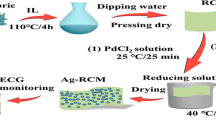Abstract
A NASICON-type ceramic (high sodium ion conductor) is proposed to record bioelectric signals. The electrode does not need gel before its application. The principle of the measurements is based on a sodium ion exchange between the skin and the material. Electrical measurements performed in saline solutions show that the electrode is slightly polarisable. The skin-electrode impedance was investigated. The impedance decreases as a function of the time of application. The resistive component is the major source of the impedance change. This can be explained by the perspiration process which occurs immediately with time after the application of the NASICON-based electrode on the skin. The skin condition is also an important parameter. NaCl saline solution or abrasion causes the resistance to decrease markedly.
Similar content being viewed by others
References
Burnette, R. R., andBagniefski, T. M. (1988): ‘Influence of constant current iontophoresis on the impedance and passive Na+ permeability of excised nude mouse skin’,J. Pharmaceutical Sci.,77, pp. 492–497
Caneiro, A., Fabry, P., Khireddine, H., andSiebert, E. (1991): ‘Performance characteristics of sodium super ionic conductor prepared by the sol-gel route for sodium ion sensors’,Anal. Chem.,63, pp. 2550–2557
Clar, E. J., Her, C. P., andSturelle, C. G. (1975): ‘Skin impedance and moisturization’,J. Soc. Cosmet. Chem.,26, pp. 337–353
Cole, K. S., andCole, R. H. (1941): ‘Dispersion and absorption in dielectrics’,J. Chem. Phys.,9, pp. 341–351
Colomban, Ph. (1986): ‘Orientational disorder, glass/crystal transition and superionic conductivity in NASICON’,Solid State Ionics,21, pp. 97–115
Cullander, C., andGuy, R. H. (1992): ‘Visualisation of iontophoretic pathways with confocal microscopy and the vibrating probe electrode’,Solid State Ionics,53–56, pp. 197–206
Fabry, P., Montero Ocampo, C., andArmand M. (1988a): ‘Polymer electrolyte as internal ionic bridge for ion solid-state sensors’,Sensors and Actuators,15, pp. 1–9
Fabry, P., Gros, J. P., Million-Brodaz, J. F., andKleitz, M. (1988b): ‘NASICON an ionic conductor for solid state Na+ selective electrode’,Sensors and Actuators,15, pp. 33–49
Fabry, P., Siebert, E., Gondran, C., Khireddine, H., andAttari, M. (1993): ‘De nouvelles céramiques conductrices pour capteurs ioniques potentiométriques’,Sci. Tech. Technol.,24, pp. 30–37
Foley, D., Corish, J., andCorrigan, O. I. (1992): ‘Iontophoretic delivery of drugs through membranes including human stratum corneum’,Solid State Ionics,53–56, pp. 184–196
Gondran, C., Siebert, E., Fabry, P., Novakov, E., andGumery, P. Y. (1992): ‘NASICON-based electrodes for bioelectric signal measurements’. Proc. 14th Annual International Conference of the IEEE Engineering in Medicine and Biology Society, Paris, Nov., pp. 2706–2708
Grimnes, S. (1983): ‘Impedance measurement of individual skin surface electrodes’,Med. Biol. Eng. Comput.,21, pp. 750–755
Hong, H. Y. P. (1976): ‘Crystal structures and crystal chemistry in the system Na1+x Zr2Si x P3−x O12’,Mat. Res. Bull.,11, pp. 173–182
Jossinet, J., andMcAdams, E. T. (1991): ‘The skin electrode interface impedance’,Innov. Tech. Biol. Med., special issue,12, pp. 21–31
Kohli, R., Archer, W. I., Roberts, J. M. C., Cochran, A. J., andLi Wan Po, A. (1985): ‘Impedance measurements for the noninvasive monitoring of skin hydration: a reassessment’,Int. J. Pharmaceutics,26, pp. 275–287
McAdams, E. T., (1992): ‘Neurosensors: A review of some fundamental electrode parameters’. Proc. Satellite Symposium on Neuroscience and Technology: 14th Annual International Conference of the IEEE Engineering in Medicine and Biology Society, Lyon, France, Nov., pp. 226–234
Scott, E. R., andWhite, H. S. (1992): ‘Direct imaging of ionic pathways in stratum corneum using scanning electrochemical microscopy’,Solid State Ionics,53–56, pp. 176–183
Siebert, E., Caneiro, A., Fabry, P., andLevy, M. (1990): ‘Na+ exchange at the NASICON/water interface’,J. Electroanal. Chem.,286, pp. 245–251
Yamamoto, T., andYamamoto, Y. (1976): ‘Electrical properties of the epidermal stratum corneum’,Med. Biol. Eng.,14, pp. 151–158
Yamamoto, T., andYamamoto, Y. (1977): ‘Analysis for the change of skin impedance’,Med. Biol. Eng. Comput.,15, pp. 219–227
Yamamoto, Y., Yamamoto, T., andOzawa, T. (1986): ‘Characteristics of skin admittance for dry electrodes and the measurement of skin moisturisation’,Med. Biol. Eng. Comput.,24, pp. 71–77
Author information
Authors and Affiliations
Rights and permissions
About this article
Cite this article
Gondran, C., Siebert, E., Fabry, P. et al. Non-polarisable dry electrode based on NASICON ceramic. Med. Biol. Eng. Comput. 33, 452–457 (1995). https://doi.org/10.1007/BF02510529
Received:
Accepted:
Issue Date:
DOI: https://doi.org/10.1007/BF02510529




